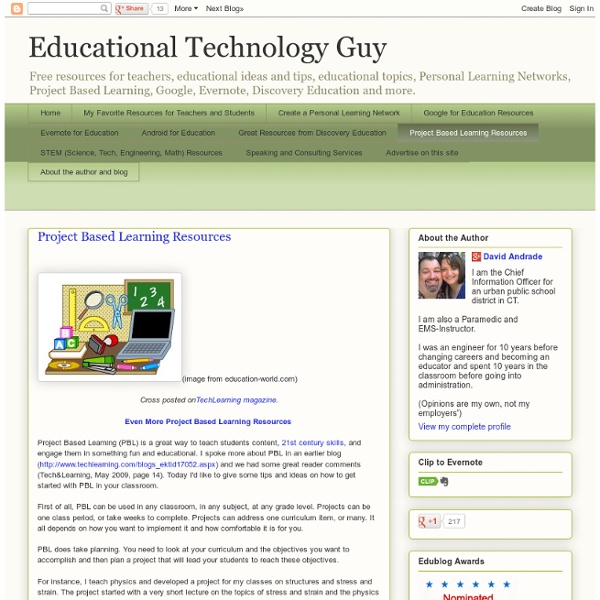Patterns: Learning, Thinking, Creating
By Kevin Washburn, on January 10th, 2012 It seems contradictory. The brain seeks and sees patterns, but when asked to find patterns, many people become uneasy. (Shelley Carson suggests that up to 80% of people find this type of thinking “uncomfortable.”1) This conundrum is the result of effort.
35 Educational Resources to Encourage Inquiry & Inventive Thinking
This is a sponsored post. I’ve scoured the internet, including all of my favourite social media sites, to bring you a fantastic collection of online inquiry and inventive thinking resources that I know will inspire and motivate both you and your students. The collection includes Lego, science, practical activity ideas, engineering, videos, animation, technology and a tonne of fun facts – so there is sure to be something for everyone! Sean Kenney Lego Certified Master Builder’s YouTube Channel: Best-selling author and artist, Sean Kenney, uses LEGO toys to build anything and everything you can imagine.
A Step-by-Step Guide to the Best Projects
Manor New Technology High School in Manor, Texas, is a 100 percent project-based learning school. They are part of the New Tech Network of schools and their approach has yielded remarkable results, including a 98 percent graduation rate, with all of their graduates accepted to college. The success of their PBL approach is largely attributable to the fact that their process is designed to stimulate student inquiry. Additionally, their process can be applied to any project in any subject, which means there is a consistent approach across grades and subjects at Manor. We followed a sophomore world studies class through a three-week project called Controlling Factors, created by teaching partners Mary Mobley (English) and Michael Chambers (world history).
Student-Centered Learning
Designing Schools for 21st Century Learning, Randall Fielding Randall Fielding, AIA, is the Chairman and Founding Partner of Fielding Nair International, LLC (FNI), an award-winning school planning and design firm with offices in Minneapolis, Tampa, Madison and Melbourne, Australia. The firm has consultations in 23 states around the U.S. and 26 countries. Randy oversees FNI’s primary mission to improve learning by serving as a world leader in the creation of new and renovated educational campuses that are in consonance with best practice and research.
Math Projects
About Project-Based Learning Projects help students personalize their learning and are ideal for gaining key knowledge and understanding of content and answering the question: Where am I ever going to use this?" Among the greatest benefits of project-based learning (PBL) are gains in students' critical-thinking skills and development of their interpersonal and intrapersonal skills. PBL is also an ideal way to help learners gain speaking and presentation skills indentified in the Common Core Standards.
The c MOOC as knowledge ecologies
Thanks to Stephen Downes for the reference to Dr. Mohamed Amine Chatti’s Knowledge Management: A Personal Knowledge Network Perspective. Here are some abstracts that I would like to quote:
Social Media for Teachers: Guides, Resources, and Ideas
Although students are evermore connected to the social web, many of these networks remain out-of-class digital playgrounds where students congregate. In a 2014 survey of 1,000 teachers, just one in five said they use social media regularly with students. Of course, it can be a challenge to incorporate social media into lessons. There are many gray areas for teachers to navigate, like setting guidelines, accessibility at school, and student safety. But to help teachers navigate this ever-changing landscape of social media tools, here are some of the best guides on the web for four popular networks, Facebook, Instagram, Twitter, and Pinterest. More Great Reads From Edutopia
Einstein’s Secret to Amazing Problem Solving (and 10 Specific Ways You Can Use It)
Einstein is quoted as having said that if he had one hour to save the world he would spend fifty-five minutes defining the problem and only five minutes finding the solution. This quote does illustrate an important point: before jumping right into solving a problem, we should step back and invest time and effort to improve our understanding of it. Here are 10 strategies you can use to see problems from many different perspectives and master what is the most important step in problem solving: clearly defining the problem in the first place! The Problem Is To Know What the Problem Is
A Parent's Guide to 21st-Century Learning
You’ll find a selection of outstanding online resources and projects, sorted by grade levels, to provide a glimpse of successful school programs. Elementary School: The World Peace Game Skype in the Classroom Peace Helpers Become Classroom Problem Solvers Middle School: Down the Drain Digiteen: Digital Citizenship for Teenagers World of Warcraft in School High School:
Opportunities Abound
Capitalize on the talents of special needs students The team of four fifth-grade teachers sat around the table at Applewood Intermediate School planning an upcoming science project. How could their students help the community become better recyclers?
edutopia
Videos can be an effective tool for teaching and learning English (or, for that matter, any academic subject) if used strategically and not as a "babysitting" device. My colleague Katie Hull Sypnieski and I wrote a previous post for Edutopia titled Eight Ways To Use Videos With English-Language Learners that shares instructional strategies for many kinds of clips. Here are a few of my favorite videos to use with those exercises. Video Playlist: Resources for English-Language Learners Watch the player below to see the whole playlist, or view it on YouTube. Mr.



